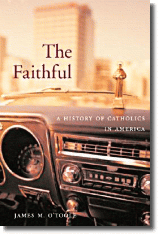
He applied the "Page 99 Test" to his new book, The Faithful: A History of Catholics in America, and reported the following:
Page 99 of The Faithful discusses the role of immigrants in the Catholic Church in the US in the 19th century. In many ways, the story of the church in this country has been the story of immigrants, and this is as true today as it was in the past. Then, Catholic immigrants were coming mostly from Europe; today, they are from all over the world: Central and South America, the Caribbean, Africa, and Asia. The ways in which the church has helped in their acculturation to their new country and the ways in which they have changed the church itself are very much a part of the story this book tells.Read an excerpt from The Faithful, and learn more about the book at the Harvard University Press website.
I also hope, however, that the book complicates that story. In the past, historians have tended to divide American Catholic history neatly into 3 periods: the pre-immigrant, immigrant, and post-immigrant church. I argue that it's better to think of six, which I call the Priestless Church (of the colonial era); the Church in the Democratic Republic (in the years before the Civil War); the Immigrant Church; the Church of Catholic Action (the early 20th century); the Church of Vatican II (the later 20th century); and the Church in the Twenty-first Century. By focusing on the experience of lay people, rather than the hierarchy and institutions of the church, I try to outline the characteristics of each period. In light of the still-ongoing crisis caused by the clergy sexual abuse scandal, understanding this history is, I believe, the first step in moving forward.
Visit James O'Toole's faculty webpage.
--Marshal Zeringue



